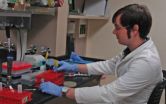Plan to one day end the use of environmentally harmful chemicals on commercial crops developed
Researchers have published a step by step plan to one day end the use of environmentally harmful chemicals on commercial crops by developing plants that produce their own fertilizer
2011-07-22
(Press-News.org) (Edmonton) Two University of Alberta researchers have published a step by step plan to one-day end the use of environmentally harmful chemicals on commercial crops by developing plants that produce their own fertilizer.
U of A plant biologist Allen Good says the energy required to produce nitrogen fertilizers has pushed the world-wide cost for agricultural producers to a $100 billion a year. Good says that while they are necessary for high yields, those nitrogen fertilizers also damage the environment. Emissions from nitrogen fertilizers add to greenhouse gas emissions and chemical run-off from farm fields cause algae blooms in fresh water lakes and rivers. Good says the cost of cleaning up the environment adds another $50 billion to the world-wide cost of commercial agriculture fertilizers.
Good and his U of A co-author Perrin Beatty says some plants, like peas, have the natural ability to split atoms of nitrogen gas and use the bioactive elements that enhance growth. Mass produced and consumed cereal crops like wheat, rice and maize cannot naturally split nitrogen atoms and need commercial fertilizers. Fertilizer producers use huge amounts of natural gas to to split nitrogen atoms to supply its bioactive components that are then spread on fields in the form of a chemical .
Good and his U of A co-author Perrin Beatty say the fix is to genetically alter agricultural products like cereal crops so they can process nitrogen from the atmosphere naturally and still get the same growth enhancing effect as commercial fertilizers.
Good and Beatty have published their perspective on Future Prospects for Cereals That Fix Nitrogen in the journal Science. The paper will be published by Science on Friday, 22 July 2011.
INFORMATION:
Contact: Allen Good
Phone: 1.780.492.1905
Cellphone: 780.435.5377
Email: allen.good@ualberta.ca
END
ELSE PRESS RELEASES FROM THIS DATE:
2011-07-22
Tel Aviv — Circadian rhythms — the natural cycle that dictates our biological processes over a 24-hour day — does more than tell us when to sleep or wake. Disruptions in the cycle are also associated with depression, problems with weight control, jet lag and more. Now Prof. Yoav Gothilf of Tel Aviv University's Department of Neurobiology at the George S. Wise Faculty of Life Sciences is looking to the common zebrafish to learn more about how the human circadian system functions.
Prof. Gothilf and his Ph.D. student Gad Vatine, in collaboration with Prof. Nicholas Foulkes ...
2011-07-22
RIVERSIDE, Calif. (www.ucr.edu) -- Do people believe good and bad luck can be washed away?
Yes, according to an advanced online publication in the Journal of Experimental Psychology that was co-authored by Rami Zwick, a University of California, Riverside marketing professor in the School of Business Administration.
Zwick, working with Alison Jing Xu of the University of Toronto, and Norbert Schwarz of the University of Michigan, designed two experiments that showed risk taking depends on whether participants recalled a past episode of good or bad luck and whether they ...
2011-07-22
A study by the University of the Basque Country (UPV/EHU) shows that people who use cosmetics buy these products primarily for emotional reasons. The study was carried out on facial creams (hydrating and nutritive ones, coloured or non-coloured, and anti-wrinkle creams) and body creams (firming and anti-cellulite creams).
"The study shows that both the emotional and utility aspect of cosmetic brands have a significant impact on consumer satisfaction, but that the emotional component has a greater effect", Vanessa Apaolaza, a researcher from the UPV and lead author of ...
2011-07-22
Today, the body of an ordinary family car consists of 193 different types of steel. The steel for each part of the car has been carefully selected and optimised. It is important, for example, that all parts are as light as possible because of the fuel consumption, whereas other parts of the car have to be super strong in order to protect passengers in a collision.
Super strong nanostructured metals are now entering the scene, aimed at making cars even lighter, enabling them to stand collisions in a better way without fatal consequences for the passengers. Research into ...
2011-07-22
Engineers at the University of Leicester have for the first time created a way of measuring how much force is used during a stabbing using a broken bottle. The advance is expected to have significant implications for legal forensics.
A team from the University has conducted a systematic study of the force applied during a stabbing and come up with the first set of penetration force data for broken glass bottles. This work has been published in the International Journal of Legal Medicine (http://www.springerlink.com/content/v21t5g05250n22xw/)
Stabbing is the most ...
2011-07-22
Researchers from the United States and Europe involved in an NIH-funded multicenter study have determined that increased body mass index (BMI) is an independent predictor of clinical decompensation in patients with compensated cirrhosis, independent of portal pressure and liver function. The findings suggest obesity accelerates cirrhosis progression and measures to reduce BMI could improve the prognosis for patients with advanced liver disease. Study details are available in the August issue of Hepatology, a journal published by Wiley-Blackwell on behalf of the American ...
2011-07-22
Incidence rates of hepatocellular carcinoma (HCC) and intrahepatic cholangiocarcinoma (ICC) have increased in the U.S. This population-based study publishing in the August issue of Hepatology, a journal of the American Association for the Study of Liver Diseases, found that metabolic syndrome significantly increases risk of developing these primary liver cancers.
According to data from the National Cancer Institute, 24,120 new cases of liver and intrahepatic bile duct cancer and close to 19,000 deaths from the diseases occurred in the U.S. in 2010. Major risk factors ...
2011-07-22
A software program developed by a Penn State synthetic biologist could provide biotechnology companies with genetic plans to help them turn bacteria into molecular factories, capable of producing everything from biofuels to medicine.
"It's similar to how an engineer designs a plane or a car," said Howard M. Salis, assistant professor in agricultural and biological engineering, and chemical engineering. "When designing a biological organism, there are many combinations that the engineer must test to find the best combination. This technology allows us to quickly identify ...
2011-07-22
This release is available in German.
VIDEO:
Red-colored adenovirus particles are found in the periphery of a human epithelial cell and steadily move towards the cell nucleus at the bottom of the image. The endocytic vesicles in...
Click here for more information.
Mucosal epithelia do not have any receptors on the outer membrane for the absorption of viruses like hepatitis C, herpes, ...
2011-07-22
When competing for food and resources, bacteria employ elaborate strategies to keep rival cells at bay. Scientists have now identified a pathway that allows disease-causing bacteria to attack other bacterial cells by breaking down their cell wall.
Pseudomonas aeruginosa is a type of bacteria readily found in everyday environments. It easily forms colonies in a wide variety of settings, including medical devices, body organs and skin wounds. This allows it to cause disease and act as a major pathogen, particularly in hospitals.
Research led by Joseph Mougous, assistant ...
LAST 30 PRESS RELEASES:
[Press-News.org] Plan to one day end the use of environmentally harmful chemicals on commercial crops developed
Researchers have published a step by step plan to one day end the use of environmentally harmful chemicals on commercial crops by developing plants that produce their own fertilizer


